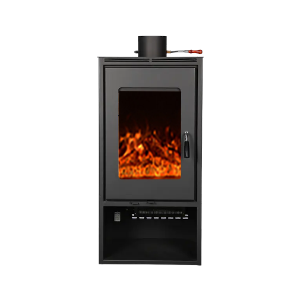The factor to consider when selecting a freestanding fireplace is the fuel type. Different fuel sources impact the efficiency, maintenance, and ambiance of the fireplace. The main fuel types available are wood, gas, and electric.

Wood-burning fireplaces: These are the traditional choice for many homeowners who love the rustic feel and natural aroma of burning wood. They create a crackling sound and provide authentic warmth. However, wood-burning stoves require a chimney, regular cleaning, and the storage of firewood. The warmth they produce is long-lasting and ideal for colder climates.
Gas fireplaces: Gas freestanding fireplaces use either natural gas or propane as a fuel source. They are known for being highly efficient and low-maintenance compared to wood-burning fireplaces. Gas models offer instant heat, adjustable flames, and require minimal cleaning. They do not need a chimney, as ventless or vented models are available. Gas fireplaces are good for homeowners seeking convenience and ease of use.
Electric fireplaces: If you're looking for a modern, clean-burning option, electric fireplaces are the way to go. These units don't require ventilation or a chimney, making them easier to install and more flexible in terms of placement. While they do not provide the same level of heat as wood or gas models, electric fireplaces can still add warmth to a room and create an inviting atmosphere with realistic flame effects. They are ideal for those who want an eco-friendly, hassle-free option.
The design of a freestanding modern fireplace can significantly impact the overall aesthetic of your living space. Modern fireplaces come in a wide range of styles, materials, and finishes. Whether you're looking for a minimalist, industrial, or contemporary design, there's a style to complement every home decor.
Contemporary Designs: Sleek lines, clean edges, and glass panels are hallmarks of contemporary freestanding fireplaces. These models often feature metal or glass exteriors and a modern, geometric shape. They are a popular choice for homeowners who want a stylish, statement-making feature.
Traditional Styles: For those who prefer a more classic look, freestanding fireplaces are available in timeless materials such as cast iron, copper, and steel. These models often have intricate details and ornate finishes that exude elegance and charm.
Minimalist Options: Minimalism is a strong trend in modern design, and many freestanding fireplaces fit this theme. These units are compact, with simple, unadorned exteriors that allow the flames to be the focal point. They are good for small spaces or for homeowners who prefer clean, understated lines.
When choosing the design, ensure that it complements the existing decor of the room. A well-chosen fireplace can enhance the space, while the wrong one can clash with your interior style.
The size of the freestanding fireplace is another important consideration. The unit should be proportionate to the space available in your home. A large fireplace in a small room can overpower the space, while a small unit in a large room may not provide sufficient heat.
Room Size: Measure the area where you intend to place the fireplace. Consider the room's size and layout to determine how much heat is required to adequately warm the space. Larger rooms may need a more powerful unit, while smaller rooms can benefit from a more compact model.
Placement Flexibility: Freestanding fireplaces are known for their versatility in placement. Depending on the model, you can position the unit anywhere in the room. Some freestanding models can be placed against a wall, while others can be installed in the middle of the room as a centerpiece. Choose a location that allows for heat distribution and visual appeal.
Clearances: Always check the manufacturer's specifications for clearances around the fireplace. There should be enough space between the unit and any furniture or combustible materials to ensure safe operation.








